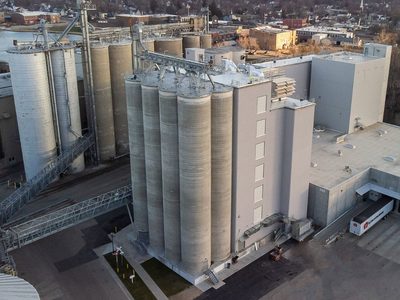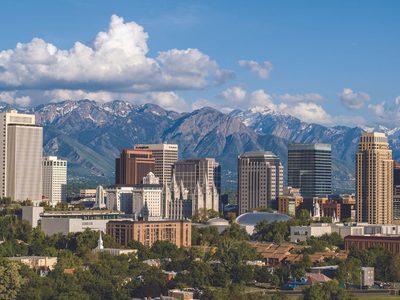Whether you are going to build a completely new facility, expand an existing one, or replace worn out equipment, it all comes at a financial cost. The amount of money a company should invest in these projects is based on making the correct decisions. These decisions include the initial cost, the useful life that can be expected, the maintenance and upkeep, and the cost to replace the investment at a future point. Factors affecting the maintenance and upkeep and the useful length of life are selecting the correct material, housekeeping, operating conditions, environmental conditions and loads and stresses to which the facility and/or equipment is subjected.
Concrete versus Steel Mill Construction
When choosing the best type of construction for a new mill or a major expansion, one has to consider whether to construct it out of steel, concrete or a combination of both. It is generally much more economical to build a small mill of steel construction. The advantages of using steel construction include lower overall cost, faster construction and easily expanded overhead bin clusters. Steel does have disadvantages in having a limited lifetime, limited bin sizes, often limited production capacities and more maintenance and upkeep requirements. Concrete has the advantages of longer lifespan, larger bin capacities, larger production capacity and less maintenance and upkeep.
On the negative side, concrete construction is overly expensive for a small mill, takes longer to construct and has limited overhead bin expansion capabilities unless a separate unit is built next to the original facility on a separate foundation.
Once the type of construction is chosen, there are many additional considerations when choosing the equipment.
Sheet Metal Choices
For these articles, we are going to look at the types of metal and finishes used in mill construction. Correct metal selection is a critical decision. Let’s look at four different types of metals – carbon steel, abrasion resistant steel, galvanized steel and stainless steel – and their uses.
Carbon steel (CS) is the most common steel used in manufacturing bin clusters and equipment. It is available in rolled sheets or shaped members such as angles and beams. It is subject to rusting when exposed to air and moisture. It also is attacked easily when exposed to acidic conditions. Carbon steel is somewhat soft and will wear easily due to materials sliding or impacting it. Carbon steel sheets can be bent and formed into different shapes. It is most economical when moisture and wear are not a problem.
Abrasion resistant (AR) steel is a treated form of carbon steel which has been heat treated to make a harder surface. It is somewhat brittle and difficult to bend into tight corners without overstressing the metal and cracking it. It does however, make a very good liner for areas in which ingredients or product impact or slide on the surface. Other than being most resistant to wear, it has the other characteristics of carbon steel.
Galvanized metal (Gal) is normally carbon steel that has been rolled through a galvanizing process which coats the surface with a moisture resistant zinc alloy coating. It is highly resistant to rust when exposed to moisture and air. It can still be attacked when exposed to acidic conditions. The galvanized coating is an excellent protector of carbon steel in wet conditions but is not a good wear surface for materials sliding on or impacting it. It is most economically used where moisture is, but wear is not a problem. When galvanized sheeting is sheared, the carbon steel is exposed around the edges of the sheet. This edge can lead to rusting of the exposed carbon steel edge. To avoid any raw edges in fabrication, a finished piece may be put through a hot dipped galvanizing process which encapsulates all surfaces and edges in a continuous galvanized coating.
Stainless steel (SS) is a special type of steel that resists both moisture and most corrosion problems. It wears very well and offers a long life. It is best used when moisture and/or corrosion are a major problem. It will usually last 4-5 times longer than carbon steel and 2-3 times longer than galvanized metal in situations where carbon steel is usually used. The selection of thickness and type of meal used has a great impact on the useful life of the bins and equipment.
Sheet Metal Options
Sheet metal is usually found in thickness of 3/16” (inches) or less. The thickness of these sheets is designated by a term called “gauge.” Metal sheets of 3/16” thickness or greater are identified as metal plate.
The estimated comparative cost of sheet metals per pound are CS = $0.30/pound, AR = $0.75/pound, GALV = $0.48/pound and 304 SS = $1.28/ pound. Table 1 (above) shows a comparison of common sheet metal gauges and their cost per square foot for each metal type. Fabrication costs are similar, but galvanized and stainless steel metals require advanced welding techniques.
Carbon steel is used in most application for metal overhead bin clusters and conveying equipment construction. Galvanized steel and stainless steel are used in wet or exterior applications. Abrasion resistant steel is used as a liner in spouting or where material slides along the surfaces.
Overhead Bin Clusters
When using carbon steel construction, it is necessary to paint all exterior surfaces to avoid rust and corrosion due to normal atmospheric conditions. Interior surfaces also need some type of resistant coating to avoid areas with moist conditions. The interior surfaces under the roof cover and/or sides above product levels are always subject to condensation buildup if the product temperature in a bin exceeds that of the metal bin walls or roof. Thus, consideration should be given as to how the walls are specified or coated to avoid problems.
When carbon steel is painted, it must be properly prepared prior to painting it. A proper primer base coat is applied. It is followed by the application of the exterior paint coating. In order for painting to be successful, the surface to be painted must be properly prepared, the proper application method used, and the correct paint used. Even the best applied paint has an estimated lifetime of 7-10 years before repainting is needed. Repainting in the field is expensive and never as good as a factory applied paint job. A field repaint job with a three-man crew can cost $7,200 a week or more not including the paint, scaffolding, crane or other supplies.
In interior locations inside overhead bin clusters subject to moist conditions, it is best to use an epoxy coating or stainless steel construction. This is also true in bins storing salt, calcium or dry lysine, dry methionine or other ingredients that are abrasive, acidic or hydroscopic.
Table 2 (page 78) is a comparison of the cost of a cluster of nine 8-foot-x-8 -foot bins in a three-bin-long by 3-bin-wide configuration with 23-foot, 8-inch-tall walls with hoppers. These bins are designed to hold 34 tons of 45-pound-per-cubic-foot material.
A 30-foot-tall carbon steel structural support with a mezzanine floor will add about $50,000 in costs. All primed exterior surfaces would have to be field painted unless ordered from the factory with a final exterior paint coat.
The cost of primed exterior and galvanized exterior is approximately the same, but the primed exterior still needed a field coat of paint applied. This can cost $9,000 or more depending on the paint type chosen and access to the areas requiring paint.
Knowing the products and densities you will put in a bin will help in deciding what level of bin construction and finish will be needed. It is a decision whether to go inexpensive and pay replacement costs a few years from now or build it to last initially. The decision is yours. Good selection may cost more initially but be more cost effective in the long run. It is up to you to consider your options and your needs. Pay extra initially or pay much more to maintain and replace the bins in the future.
Some of the information in this article was obtained from Steel & Pipe Supply Co., Manhattan, Kansas, U.S. and Tom-Cin Metals, Inc., Hortonville, Wisconsin, U.S.
Fred Fairchild is feed science professor emeritus in the Department of Grain Science at Kansas State University. Prior to coming to Kansas State in 1994, he worked in the industry designing, constructing and commissioning numerous mill facilities. He is a licensed professional engineer. He can be reached by e-mail at [email protected].





